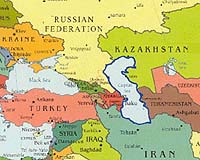| . |  |
. |
University Park PA (SPX) Mar 19, 2010 An interdisciplinary team of physicists and geologists led by the University of Pennsylvania has made a major step toward predicting where and how large floods occur on river deltas and alluvial fans. In a laboratory, researchers created a miniature river delta that replicates flooding patterns seen in natural rivers, resulting in a mathematical model capable of aiding in the prediction of the next catastrophic flood. The results appear in the current issue of Geophysical Research Letters. Slow deposition of sediment within rivers eventually fills channels, forcing water to spill into surrounding areas and find a new, steeper path. The process is called avulsion. The result, with the proper conditions, is catastrophic flooding and permanent relocation of the river channel. The goal of the Penn research was to improve prediction of why and where such flooding will occur and to determine how this avulsion process builds deltas and fans over geologic time. Research was motivated by the Aug. 18, 2008, flooding of the Kosi River fan in northern India, where an artificial embankment was breached and the resulting floodwaters displaced more than a million people. Looking at satellite pictures, scientists from Penn and University of Minnesota Duluth noticed that floodwaters principally filled abandoned channel paths. Meredith Reitz, lead author of the study and a graduate student in the Department of Physics and Astronomy in Penn's School of Arts and Sciences, conducted a set of four laboratory experiments to study the avulsion process in detail. Reitz injected a mixture of water and sediment into a bathtub-sized tank and documented the formation and avulsion of river channels as they built a meter-sized delta. "Reducing the scale of the system allows us to speed up time," Reiz said. "We can observe processes in the lab that we could never see in nature." The laboratory experiments showed flooding patterns that were remarkably similar to the Kosi fan and revealed that flooding and channel relocation followed a repetitive cycle. One major finding was that the formation of a river channel on a delta followed a random path; however, once a network of channels was formed, avulsion consistently returned flow to these same channels, rather than creating new ones. An additional important finding was that the average frequency of flooding was determined by how long it took to fill a channel with sediment. Researchers constructed a mathematical model incorporating these two ideas, which was able to reproduce the statistical behavior of flooding. "Avulsions on river deltas and fans are like earthquakes," said Douglas Jerolmack, director of the Sediment Dynamics Laboratory in the Department of Earth and Environmental Science at Penn and a co-author of the study. "It is impossible to predict exactly where and when they will occur, but we might be able to predict approximately how often they will occur and which areas are most vulnerable. Just as earthquakes occur along pre-existing faults, flooding occurs along pre-existing channel paths. If you want to know where floodwaters will go, find the old channels." The authors derived a simple method for estimating the recurrence interval of catastrophic flooding on real deltas. When used in conjunction with satellite images and topographic maps, this work will allow for enhanced flood hazard prediction. Such prediction is needed to protect the hundreds of millions of people who are threatened by flooding on river deltas and alluvial fans. The work could also help in exploration for oil reservoirs, because sandy river channels are an important source of hydrocarbons.
Share This Article With Planet Earth
Related Links University of Pennsylvania Bringing Order To A World Of Disasters When the Earth Quakes A world of storm and tempest
 At least 30 dead, thousands evacuated in Kazakh floods
At least 30 dead, thousands evacuated in Kazakh floodsTaldykorgan, Kazakhstan (AFP) March 12, 2010 At least 30 people were killed and thousands evacuated from their homes in southern Kazakhstan Friday when two burst dams unleashed massive flooding, officials said. Flood waters from rivers swollen by unusually heavy winter snowfalls and an early spring spilled over the walls of a dam in the southern Aksuisky district and washed away a second in the nearby Karatalsky district. By Friday ... read more |
|
| The content herein, unless otherwise known to be public domain, are Copyright 1995-2010 - SpaceDaily. AFP and UPI Wire Stories are copyright Agence France-Presse and United Press International. ESA Portal Reports are copyright European Space Agency. All NASA sourced material is public domain. Additional copyrights may apply in whole or part to other bona fide parties. Advertising does not imply endorsement,agreement or approval of any opinions, statements or information provided by SpaceDaily on any Web page published or hosted by SpaceDaily. Privacy Statement |